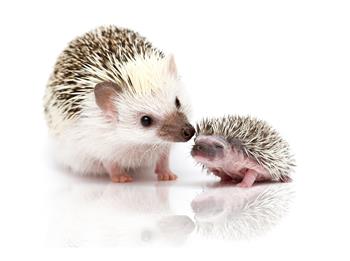Hedgehogs

Origin
North Africa, Morocco, Libya, Spain, Southern France and several island groups north of Africa
Description
Adults weigh approximately 1 pound and are 4 to 6 inches in length. They are basically nocturnal animals that have gained popularity as exotic pets because of their small size and ease of care.
Feeding
Hedgehogs are insectivores and have an extremely high metabolic rate. In the wild, hedgehogs consume a variety of insects, worms, small vertebrates, small roots and plant material. In captivity, the staple of their diet can be a high quality hedgehog food by Sugar Gliders *R* Us -Hedgehog Chow* sprinkled with Hedgehog booster*. Meal worms*, Crickets* and small amounts of fruits and vegetables may be added sparingly. Feeding bowls should be heavy/stable (they love to root) . Make sure they always have fresh water. Water bottles* work well and are much cleaner than a bowl. Just make sure you see them drinking from the bottle.
Housing
Hedgehogs do not require sophisticated housing. They can be housed in large aquariums, tubs or wire cage with solid bottom tray with sides so that they can't climb up to wire (not good climbers). They are usually housed in pairs or individually. Aspen bedding can be used but should be changed frequently. Do not use cedar or pine shavings, they contain aromatic oils that cause irritation to the eyes, mucous membranes and respiratory tract. An exercise wheel is also recommended. It should have a solid cylinder so that the hedgies feet don't get caught. Hedgehogs tend to be surprisingly energetic, and need the chance to use up some of this energy. Hedgehogs can be trained to use a litter box but dust-free litter should be used. A hide should be provided for privacy. We use a igloo* and Hedgie Sack*.
Temperature
The ideal temperature ranges from 70 to 90 degrees F. All hedgehogs will hibernate when the environmental temperature drops below 65 degrees F. In the wild, hedgehogs hibernate from November to March. Heat exhaustion can be a serious problem if proper shade or temperature controls are not provided. It's a good idea to have a heat source like a under tank heating pad* or heating pad* that stays on under their cage in the corner. That way they always have a warm place to go to.
Breeding
Gestation ranges from 35 to 42 days with litter sizes of 2 to 6. Young hedgehogs can be weaned at 5 to 6 weeks and can begin breeding as early as 3 months of age.
Socializing
An untamed hedgehog is very shy and will roll up and spike out his spines defensively. Getting your baby hedgie to become familar with you will take patience. Spend lots of time holding your baby and it will get more use to you and begin to relax. Hedgehogs have poor eye sight so they use smell as their primary sense. Your hedgie will learn to identify you by smell. The best way to do this is to spend time with your pet several times a day just gently holding it to allow it to adjust to you and learn to recognize your scent. The best way to pick up a hedgie is with one hand on each side of him then bring your hands gently together to cup under him. As your hedgehog adjust to being held, it will usually come to you with his quills lying flat, allowing you to play with and pet him. Mine love to travel with me in a Hedgehog Carry Pouch* and take baths with HOGWASH*.
Longevity
Up to 8 years
